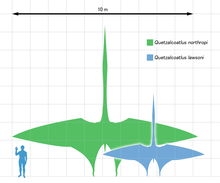Quetzalcoatlus
| Quetzalcoatlus | ||||||||||||
|---|---|---|---|---|---|---|---|---|---|---|---|---|

Reconstructed life picture of Quetzalcoatlus moving on four legs . One has captured a juvenile titanosaur . |
||||||||||||
| Temporal occurrence | ||||||||||||
| Upper Cretaceous ( Maastrichtian ) | ||||||||||||
| 72 to 66 million years | ||||||||||||
| Locations | ||||||||||||
| Systematics | ||||||||||||
|
||||||||||||
| Scientific name | ||||||||||||
| Quetzalcoatlus | ||||||||||||
| Lawson , 1975 | ||||||||||||
Quetzalcoatlus is a genus of pterodactyls (Pterosauria) from the late Cretaceous of North America (72-66 mya ). As one of the largest known pterosaurs, it was also one of the largest airworthy animals in the history of the earth . The genus is named after the Mesoamerican deity Quetzalcoatl , who was usually depicted as a feathered snake. The addition of the type species Q. northropi , the only scientifically described species of the genus, is reminiscent of John Knudsen Northrop , a designer of flying wing aircraft .
description
Quetzalcoatlus had an estimated wingspan of 11 to 13 meters. Its hollow bones allow a very low weight of only approx. 100 kg for its size; other sources assume up to 200 kg. The fuselage was very small compared to the wingspan. The species was probably not a persistent active aviator, but covered long distances in soaring flight , whereby they, similarly large birds such as z. B. Old World vultures , exploiting thermal air currents and thus could stay in the air for hours with minimal expenditure of energy. Quetzalcoatlus could probably take off from the ground on its own, but needed favorable wind conditions for this. Whether the long, pointed beak had teeth is unclear, as is the question of whether Quetzalcoatlus moved biped or quadruped on the ground , although the latter theory is gradually gaining acceptance.
There are different opinions about his way of life. With its long cervical spine and long beak-like snout, it could have hunted fish, wading like a heron in shallow water. However, it is also assumed that, similar to a marabou , it could have fed on carrion.
distribution
Fossil finds are known from Central and North America . During the Cretaceous Period, a shallow epicontinental sea , the Western Interior Seaway, spread over large parts of North America . The climate in Texas during this period was similar to that of today's tropical seashores. Quetzalcoatlus lived on the seashore by the floodplains and lagoons . Bones of related species were discovered in Dinosaur Provincial Park in the Canadian province of Alberta .
discovery
The first fossil of this pterosaur, part of the wing, was discovered in 1971 by the student Douglas A. Lawson in Big Bend National Park , Texas , and scientifically described by him in 1975 .
literature
- Peter Wellnhofer : The illustrated encyclopedia of pterosaurs. Crescent Books, New York NY 1991, ISBN 0-517-03701-7 .

